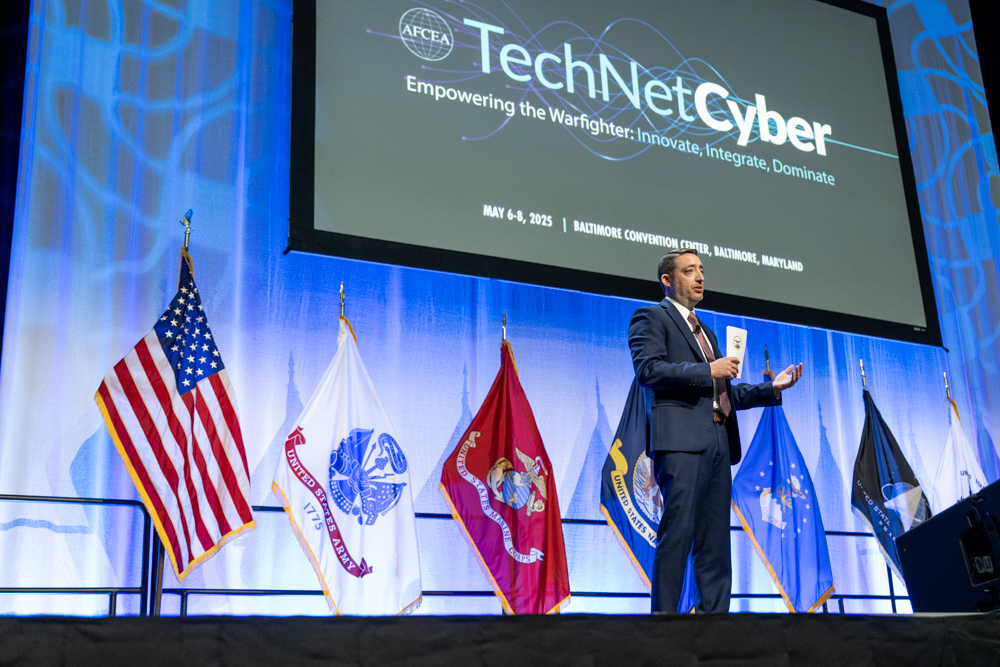By Marco A. Villasana Jr., DISA Strategic Communication and Public Affairs
May 9, 2025

Defense Information Systems Agency Deputy Director Christopher Barnhurst opened his keynote at AFCEA TechNet Cyber 2025 with this quote from Mike Tyson, “Everyone has a plan until they get punched in the face,” highlighting the need for readiness, agility and strong partnerships in an increasingly contested cyber domain.
Barnhurst’s message was grounded in the agency’s focus on unity and momentum. He emphasized its commitment to DISA Director and Joint Force Headquarters – Department of Defense Information Network Commander Army Lt. Gen. Paul T. Stanton’s four priorities — readiness, campaigning, continuous modernization and establishing lethality. Furthermore, he underscored the essential role industry partners play in DISA’s mission.
“At DISA, we are a team,” Barnhurst said. “And that team extends to all of you. One of the first things Lt. Gen. Stanton would say is, if you contract with DISA, you’re on the team. It’s a partnership.”
This partnership, he explained, is not just a formality but a foundation for operational success. He pointed to DISA’s Thunderdome program — an integrated zero trust architecture built from dozens of industry-provided products — as a key example of what’s possible through collaboration.
Thunderdome started as a concept on a whiteboard. Now, it’s real and it’s delivering results two years ahead of schedule, Barnhurst said. “That to me is the power of this kind of forum and what we can do when we work together as a team.”
After extensive testing, Thunderdome successfully hit on 152 of 152 key zero trust activities, as articulated by the DOD chief information officer and the department — a milestone Barnhurst called “a huge deal” for the agency and its strategic partners, including the U.S. Coast Guard.
He also clarified that while DISA is a critical contributor to defending the DODIN, it is only one of 45 DODIN areas of operation. “Each one of those 45 DAOs represents a potential vector of attack for an adversary,” he said. “You hear a lot from the department about one team, one fight. With DISA and JFHQ-DODIN, you hear the same thing from Lt. Gen. Stanton.”
In alignment with that fight, Barnhurst outlined how Stanton’s priorities are embedded in the agency’s strategy.
Readiness
Readiness, he said, begins with people — military, civilian and industry. “The adversary doesn’t distinguish between government and private infrastructure; the attack surface to them is all fair game. We have to be side by side, sort of paired at the hip with the same sight picture, so that we cannot just react to what the adversary might be doing in a conflict but also be proactive to prepare for that.”
To build that readiness, DISA is investing in career pathways for its workforce and promoting joint awareness with its partners, so people can see a future with the agency — from entry level to senior leader — and know what they need to get there.
Campaigning
The second priority, campaigning, means aligning with combatant commanders across the globe. Through DISA’s embedded field commands and field offices, Barnhurst said the agency gains critical insight into operational priorities and feeds that back into acquisition and program planning.
He explained that the agency built a governance structure that allows it to pull in prioritized requirements from the field and align them with the demand signals sent to industry. “Providing services to [combatant commands] that they can leverage with their coalition partners is desired.”
Continuous Modernization
DISA’s third priority, continuous modernization, is about leaving legacy systems behind to make room for innovation. Barnhurst acknowledged the challenges of replacing outdated technologies like time-division multiplexing but stressed that doing so is necessary to reduce costs and risk.
So, it’s not just about what the agency removes, it’s about what it enables, he said. “When we think about continuous modernization, it is both sides of that equation, reducing legacy and then freeing up dollars to invest in the new so that we can make the only man-made warfighting domain what we want it to be.”
Establishing Lethality
The final priority, establishing lethality, enables mission success across the department. Barnhurst emphasized that every major defense operation — whether it’s ballistic missile defense or securing the border — relies on DISA’s infrastructure.
“When we talk about establishing lethality, we’re talking about decision superiority,” he said. “We want the right data to get to the right place at the right time for a commander to make an operationally relevant decision.”